Citizens Bank Park
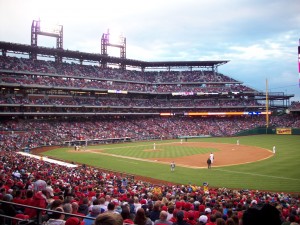 Team: Philadelphia Phillies
Team: Philadelphia Phillies
Affiliate: N/A
Ballpark Basics: A highly walkable park, which is great because you’re probably not going to get a seat.
Ballpark Breakdown:
Citizens Bank Park is located in the southern edge of Philadelphia along with the other sports complexes for the other Philadelphia sports teams: Lincoln Financial Field, home of the Philadelphia Eagles and the Wells Fargo Center, home of the 76ers and Flyers. It opened in 2004 to replace Veterans Stadium, a multi-use stadium that had been home the Phillies and Eagles since 1971. Veterans Stadium was demolished in 2004 but you can still walk by the statues and plaques that used to sit outside the Vet when walking to Citizens Bank Park from the subway.
And speaking of, the subway is possibly the best way to get to Citizens Bank Park, but there are many (many) parking lots surrounding the ballpark as well. In fact, there are over 20,000 parking spots providing easy access to any of the sport complexes in the area. Four statues are located in various spots outside of the stadium; Robin Roberts on the first base side, Steve Carlton outside of the left field entrance along with a Connie Mack statue that was originally placed outside Shibe Park (which was also known as Connie Mack Stadium), and just off the third base side, outside the gates that serve as the main entrance to the park, you’ll find a statue of Mike Schmidt.
Due to their continued  success, the Phillies have sold out every game since 2009, which makes it hard to get tickets for any game. In our case, we attempted to get tickets the day they were released, but after sitting in Ticketmaster’s “virtual waiting room” for two hours the only ones that were available were standing room only seats. They sell a ton of these seats, so if you have a specific spot that you want to stand, be sure to get their early. But if you’re not picky, there are plenty of great areas around the ballpark to watch the game from.
success, the Phillies have sold out every game since 2009, which makes it hard to get tickets for any game. In our case, we attempted to get tickets the day they were released, but after sitting in Ticketmaster’s “virtual waiting room” for two hours the only ones that were available were standing room only seats. They sell a ton of these seats, so if you have a specific spot that you want to stand, be sure to get their early. But if you’re not picky, there are plenty of great areas around the ballpark to watch the game from.
We started off behind the bullpens just to the right of center field. The bullpens are tiered with the visiting club closer to the fans, similar to the bullpens in Camden Yards The Phillies actually switched shortly after the park opened to get a better view of the game (and to move away from own rowdy fans). The bullpens butt up against Ashburn Alley, named after Phillies centerfielder Richie Ashburn. Ashburn Alley features a statue of Ashburn along with the All-Star Walk that lists every Philly All-Star by position. Also along the alley is the Mitchell & Ness Team store. The vintage uniform store originated in Philadelphia and this store is filled with great Phillies throwback items (if you can afford them).
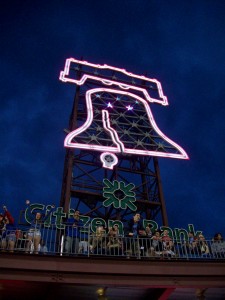 There are tributes to past Philly parks throughout Citizens Bank Park. Above the alley, there are “rooftop bleachers” that are supposed to harken back to the days of Shibe Park and the bleacher seats that were constructed on top of the houses across the street. Above the bleacher seats is the only thing that was worth bringing over from the Vet; The Liberty Bell. The 35’ x 50’ bell was doubled in size and it still lights up and rings when a Philly hits a home run. Even the clock that displays in center field appears to be a tribute to the Longines clock that hung above the scoreboard in Shibe Park.
There are tributes to past Philly parks throughout Citizens Bank Park. Above the alley, there are “rooftop bleachers” that are supposed to harken back to the days of Shibe Park and the bleacher seats that were constructed on top of the houses across the street. Above the bleacher seats is the only thing that was worth bringing over from the Vet; The Liberty Bell. The 35’ x 50’ bell was doubled in size and it still lights up and rings when a Philly hits a home run. Even the clock that displays in center field appears to be a tribute to the Longines clock that hung above the scoreboard in Shibe Park.
Red brick is dominant throughout the park, and you’ll be surrounded by it almost anywhere you wander. And wander you should; the concourse on the first level is open so you can watch the game no matter where you go. You will find that the overhang from the club level comes down too far, blocking a view of any pop ups, so you might want to head on up to the second level. The concourse here is also open which gives fans with standing room only seats an option that they don’t get in most other parks. And with less than a third of the seats located in the upper deck, if you can manage to get something other than a standing room only ticket, you’re pretty much guaranteed to be in the lower bowl, close to the action.
There are numerous options 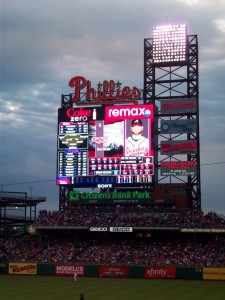 for both food and beer around the entire stadium. Even though Philly is known as the home of the cheesesteak, I don’t think I’ve ever seen the words vegetarian or vegan more that at this ballpark. It was actually voted as the most-vegetarian friendly ballpark by PETA in 2008 and 2009. Two of the most popular food options are Tony Luke’s for cheesesteaks and Chickie’s and Pete’s for crab fries, both of which had extremely long lines throughout the entire game. Behind the left field wall there is Harry the K’s, named after Harry Kalas, a sit-down restaurant that was extremely popular before the game and remained popular during the game since many of the tables afford a view of (at least some) of the game action. There is also a large interior McFadden’s Bar within the park, but the only view of the game you’re going to get from here is on television. Our visit happened to coincide with the running of the Kentucky Derby, and since McFadden’s was showing it on almost every TV, this place remained packed even after the game started (the chilly weather, and off and on rain didn’t hurt McFadden’s popularity either). You can of course, get a variety of beverages at any of these restaurants, and there are beer stations located around the park, which they call “Brewerytown” with your mix of your traditional ballpark brews (Bud, Miller) along with a variety of microbrews, including locals Yards, Philadelphia Brewing Company, Flying Fish, and Prism.
for both food and beer around the entire stadium. Even though Philly is known as the home of the cheesesteak, I don’t think I’ve ever seen the words vegetarian or vegan more that at this ballpark. It was actually voted as the most-vegetarian friendly ballpark by PETA in 2008 and 2009. Two of the most popular food options are Tony Luke’s for cheesesteaks and Chickie’s and Pete’s for crab fries, both of which had extremely long lines throughout the entire game. Behind the left field wall there is Harry the K’s, named after Harry Kalas, a sit-down restaurant that was extremely popular before the game and remained popular during the game since many of the tables afford a view of (at least some) of the game action. There is also a large interior McFadden’s Bar within the park, but the only view of the game you’re going to get from here is on television. Our visit happened to coincide with the running of the Kentucky Derby, and since McFadden’s was showing it on almost every TV, this place remained packed even after the game started (the chilly weather, and off and on rain didn’t hurt McFadden’s popularity either). You can of course, get a variety of beverages at any of these restaurants, and there are beer stations located around the park, which they call “Brewerytown” with your mix of your traditional ballpark brews (Bud, Miller) along with a variety of microbrews, including locals Yards, Philadelphia Brewing Company, Flying Fish, and Prism.
Baseball Nerd Fact #3 — While nothing remains of any of the former Philadelphia ballparks, there are historical markers denoting where all three (Baker Bowl, Shibe Park, Veterans Stadium) once stood along with a marker where home plate was for the Vet. You can also see where Connie Mack used to live at 604 Cliveden Street.
Philadelphia Brewing Company
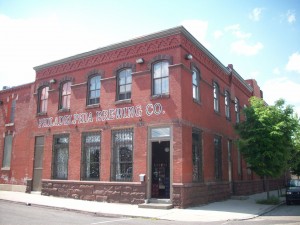 Visited: May 2011
Visited: May 2011
Guest Reviewers: Emily and Tony
Rating: Triple
Brew Basics: Go here for the atmosphere first, beer second.
PBC as it’s known locally, is the only brewery on the east coast that does its own distributing, which gives them a lot of control (obviously) over things like shelf life, product placement and pricing.(FIX) Like anything in Philadelphia, there is a lot of history associated with this brew house. Originally opened in 1994 and known as Yards Brewing, the vague story we were told is that partners split ways, and one took the name (and at least some of the beer recipes) with him, and so it was re-branded in 2008? as Philadelphia Brewing Company. But before the split, needing somewhere to set up shop, they discovered a historic warehouse, where one of the first craft breweries NAME in the country mixed their batches, and began America’s love affair with beer in the mid 1800’s. They purchased the building in 2000, and began brewing in 2001. Unfortunately, this historic building is found in a dejected part of town, the building looks run down; and though they did add some buckets of flowers, and designed the heavy wrought iron bars on the windows look like vines of ivy, it really doesn’t do much to dispel a fairly bleak welcome.
But for having one of the most uninviting outsides, 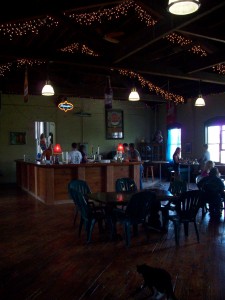 it was actually warm and friendly inside (which is saying a lot, as we had a hard time finding anything in Philly that was warm or friendly…). Immediately inside there is a small shop with the usual swag, beer by the case, and new the week we visited, growlers. — which brings us to our first brewery related complaint. No six packs for sale. But we digress. An old wooden staircase in the back of the shop takes you up to a wide open loft, with high barn beams, and a huge hay loft doors that were open for the spring day. The interior is well thought out, with a lot of intricate detail (all the way down to the bathrooms) and decorated eclectically, with bright blue curtains, a juke box that plays a lot of Beastie Boy songs, a brew tank painted like a bright pink pig for the high octane beers, a cat who has carte blanche to wander amongst the guests, and a random collection of plastic lawn chairs and old dining room tables that could only have come from some very thorough yard sale shopping. Tours are free and go out once an hour or as often as interest dictates. Our knowledgeable tour guide David wove us through several rooms of the old and new brewery, explaining the science and imparting the history of brewing along the way.
it was actually warm and friendly inside (which is saying a lot, as we had a hard time finding anything in Philly that was warm or friendly…). Immediately inside there is a small shop with the usual swag, beer by the case, and new the week we visited, growlers. — which brings us to our first brewery related complaint. No six packs for sale. But we digress. An old wooden staircase in the back of the shop takes you up to a wide open loft, with high barn beams, and a huge hay loft doors that were open for the spring day. The interior is well thought out, with a lot of intricate detail (all the way down to the bathrooms) and decorated eclectically, with bright blue curtains, a juke box that plays a lot of Beastie Boy songs, a brew tank painted like a bright pink pig for the high octane beers, a cat who has carte blanche to wander amongst the guests, and a random collection of plastic lawn chairs and old dining room tables that could only have come from some very thorough yard sale shopping. Tours are free and go out once an hour or as often as interest dictates. Our knowledgeable tour guide David wove us through several rooms of the old and new brewery, explaining the science and imparting the history of brewing along the way.
Brew Breakdown:
Hands down this was one of the best tasting experiences we have ever had. Every worker was friendly, knowledgeable and welcoming. When you start the tasting, you are told to hold on to your glass, and a steno sized sheet of paper that describes all the beers, and serves as your checklist. You’re allowed to try each one once, at your own pace, and they just mark off the beer on your sheet each time you fill up. There were 6 beers on tap and they do NOT skimp on the pour — which is even more awesome when you take into account that the tour and tasting are completely free.
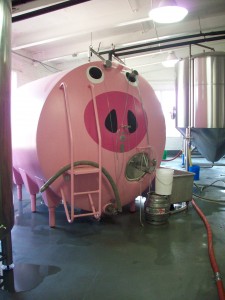 We know all this sounds perfect, so you must be wondering by now why it only ranks at a triple, and to be honest, it’s all in the beer. We had two guest reviews visiting with us that day, and none of the selections really wowed any of us; there were definitely more beers we weren’t impressed with than those we liked — including one I ended up pouring out.
We know all this sounds perfect, so you must be wondering by now why it only ranks at a triple, and to be honest, it’s all in the beer. We had two guest reviews visiting with us that day, and none of the selections really wowed any of us; there were definitely more beers we weren’t impressed with than those we liked — including one I ended up pouring out.
Kenzinger 4.5% ABV — This light golden beer was somewhat watery and had light lacing and moderate carbonation. Although there was a punch of hops at the end of the sip, the flavor wasn’t cohesive, and it really just ended up being bitter, hoppy. This ended up being one of those beers you have to aquire a taste for, and did get more enjoyable the more we drank. Basically, just a straight up pilsner – and not a bad starting point.
Walt Wit 4.5% ABV – Despite the creative name, guest reviewer Tony didn’t think there was a lot to this beer, and the rest of us agreed. Not a bad beer, it even had hints of grapefruit in the palate and aroma, but without much flavor, and definitely no bite. Wasn’t horrible, but was a let down.
Penn Pale Ale 5% ABV – This was one whose appearance and aroma held a lot of promise: high malts, hoppy, a deep golden color, and medium-high carbonation. All the things you want to see in a pale ale. But again, the flavor did not deliver, it was lightly hoppy with a lasting bittery aftertaste, but it had minimal body and the flavors didn’t really blend — this was the one we didn’t even want to finish, a first (but surely not the last) on our brew tours.
Rowhouse Red — 5% ABV – The best of the options, similar to the Kenzinger in mouth feel and aroma, it was smoother and deeper amber in color with a decent tanish ivory head that doesn’t stick around very long. The Rowhouse is dry with medium body and med/high carbonation, but don’t confuse this for a red (I know, the name is confusing) it’s really more of a rye beer which you’ll find comes through most in the aftertaste.
Fleur de Lehigh 4.75% ABV – This was a thick, yellow beer with high carbonation and a quick to dissipate head. There were light fruit smells, but the most pronounced aspects of the aroma were definitely lemongrass and ginger which combined to create a beer that was good, not at all citrusy, and as best as we could describe “tastes like I’m smelling a garden”, thanks Emily.
2439 Amber Street
Philadelphia, PA, 19125
215-427-2739 (BREW)





